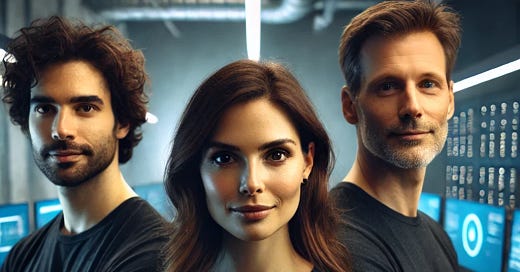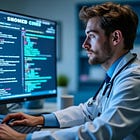Healthcare Innovation and Generative AI
About intrapreneurship, innovation in the era of Generative AI, and finding your own meaning.
This year, Microsoft is celebrating 50 years of innovation. This is my personal innovation story, as the founder of the Health & Life Sciences group in the Microsoft Israel R&D Center.
I always had passion for healthcare. Always interested in the work of doctors and reading medicine books from a young age (yes, some people are weird). But I always knew I was not going to become a medical doctor. I came from a humble background and was really good at computer science.
And so, I majored in computer science and went deep into the tech industry, managing multi-disciplinary engineering teams in tech companies.
Still loved medicine, but all these years, Health Tech was not a thing. Yet.
It was mid-career when my family was hit by a tragedy. That made me think that maybe I should have become a medical doctor after all. But it was too late for me.
Microsoft was always the top of the industry for me, so when the opportunity to join the company came, I did not think twice and joined a team that worked on personal assistants technology. This got me a step closer to my passion for creating technology that would do good for mankind.
It was late 2014 when Microsoft decided to double down on healthcare-related technology and officially announced the Health & Life Sciences division.
And I immediately knew I had to be there.
They needed personal assistant integration. Which was my expertise. And so, I engaged in an extra-curricular, innovative project with the Health & Life Sciences team in USA, on top of my day job, with help from a local incubation team.
You can think of this as karma or luck. But the truth is that this was an uphill battle, with a lot of hard work, delivering on our promises, and not giving up. I worked nights and weekends on this, for almost a year. And I made shit happen.
I shared with the company my passion for healthcare and my vision for this industry. And I also shared my aspiration to create a new team in the Israel R&D center (ILDC) that would work for the Health & Life Sciences division.
It was November 2015 when I finally got the green light to establish the new team, with 2 headcounts. Few weeks later, Shahar (from my previous team), and Gil (who worked with me in the past) both chose to take a bet on me and joined the team. That was the beginning of our journey as Health & Life Sciences ILDC.

What is Intrapreneurship?
Intrapreneurship means applying entrepreneurship within an existing organization rather than starting a new venture independently. Intrapreneurs are employees who think and act like entrepreneurs, taking initiative to drive innovation, develop new products, or create new business opportunities, while working within the framework of their company.
Intrapreneurship means applying entrepreneurship within an existing organization
Guess you can say I was an intrapreneur in that journey.
Intrapreneurship is harder than you think.
One of the biggest challenges in intrapreneurship is having limited options. Unlike entrepreneurship, where there are several VCs you could potentially get the investment from - if you were to do this outside the corporate, that is - intrapreneurship means you typically have a single executive stakeholder you need to convince. Well, maybe sometimes a team of executives within a business unit. If I hadn’t been able to convince the Corporate VP who led Health & Life Sciences at the time, the entire thing wouldn’t have happened.
Another challenge is internal resistance. To be very honest, not everyone around me liked it. I can certainly say that without the support I received from leaders in my local R&D center, I wouldn’t be here.
Balancing your day-to-day responsibilities with your intrapreneurship is another big one. I'm a hard worker, with tons of grit, and a big passion for the domain. But not everyone is cut for this.
We see a lot of innovation going on in healthcare organizations that we work with. Some of it can still be viewed as intrapreneurship, especially when it comes from the medical staff. But at least in this country, this innovation is mostly structured, coming from a designated innovation department within the healthcare organization. It’s a good trend, to see more and more healthcare organizations that choose to make innovation a priority by investing resources in it. When it is successful, some of that innovation is even translated into new streams of business for the healthcare organization.
What does innovation even mean anymore in the era of Generative AI, when you can just ask AI tools to come up with new ideas, create new music and generate art?
Generative AI is reshaping innovation
What does innovation even mean anymore in the era of Generative AI, when you can just ask AI tools to come up with new ideas, create new music and generate art?
Generative AI may be shifting what it means to be innovative. But we must remember that innovation is not just about creating something from scratch. You can create something new based on learned patterns, but it would still be more of the same.
Generative AI can create thousands of ideas, but innovation is also about choosing the right ones.
Moreover, Generative AI can create thousands of ideas, but innovation is also about choosing the right ones. An important part is identifying what ideas would actually be meaningful, ethical, and feasible to implement.
And innovation isn't just about the ideas. One of the takeaways of my story above is that execution is critical. How do you implement the thing? How do you integrate with existing systems and processes? How do you create experiences that solve real-world problems?
My take on it is that Generative AI opens the door for a whole new ballgame of innovation. It’s a new paradigm that changes how we work with technology and creates a new set of challenges we have not considered before. And those new challenges require innovation.
So, here we are
My team has grown significantly over the last decade. Our path has evolved, new products emerged, and our products re-pivoted for better market fit. We continued to work hard, drive new innovation, keep our professional integrity, and deliver on our commitments, again and again.
Today, I run a global R&D group that builds platform AI services at Microsoft Health & Life Sciences. My group is multi-disciplinary, located in multiple geographies, and we build innovative AI services that are used by thousands of healthcare organizations and millions of end-users all over the world.
Both my co-founders are still with me today.
So, this is Microsoft for you. The enabler of innovation, the driver of global impact, true to its core values, where my own vision for the future of healthcare becomes a reality.
I love my team, and I am very proud of the things we have accomplished over the years and the impact we have made. You can read about some of that in previous chapters of this blog.
So, this is Microsoft for you. The enabler of innovation, the driver of global impact, true to its core values, where my own vision for the future of healthcare becomes a reality.
To many more years of innovation, years of building meaningful technology that would make a positive difference on people’s lives, all around the world.
About Verge of Singularity.
About me: Real person. Opinions are my own. Blog posts are not generated by AI.
See more here.
LinkedIn: https://www.linkedin.com/in/hadas-bitran/
X: @hadasbitran
Instagram: @hadasbitran
Recent posts:








Great post, really inspiring. I have a question: how do you tackle the emerging regulatory landscape for AI? Do you hire specialist in your team etc.?
Amazing story, thanks for sharing … and inspiring others.